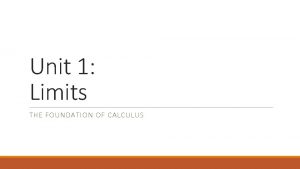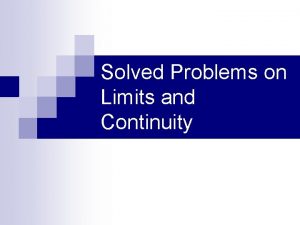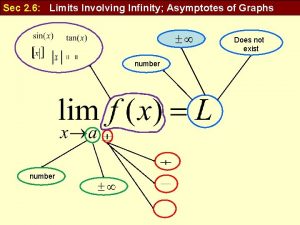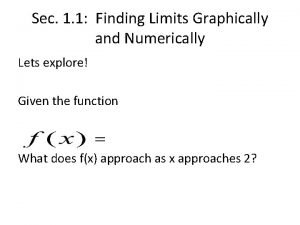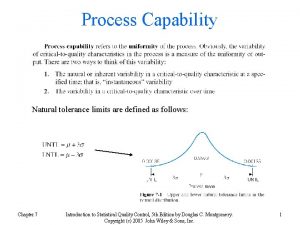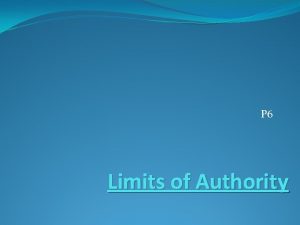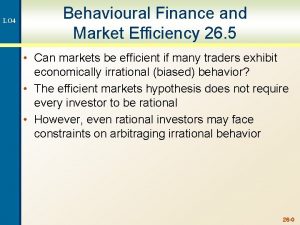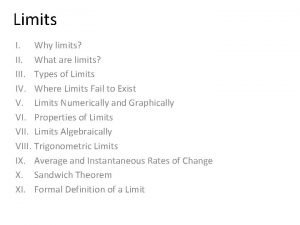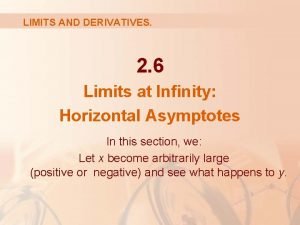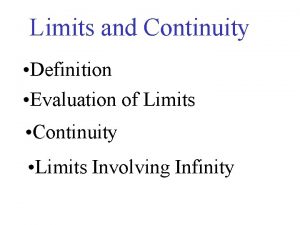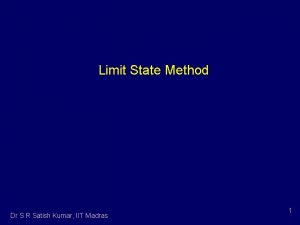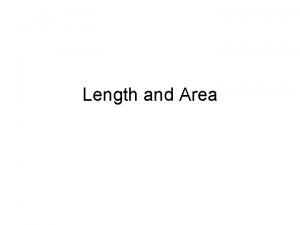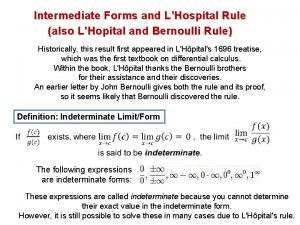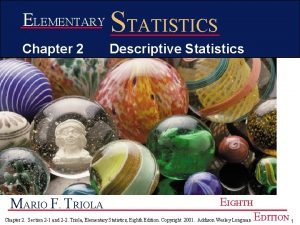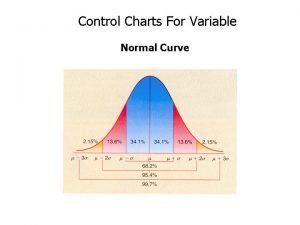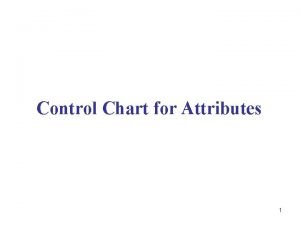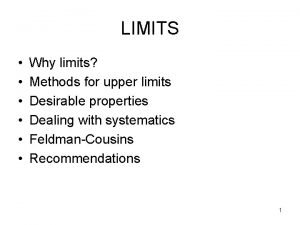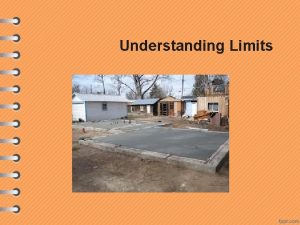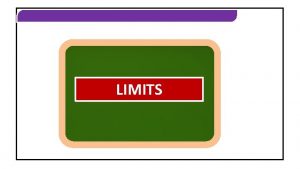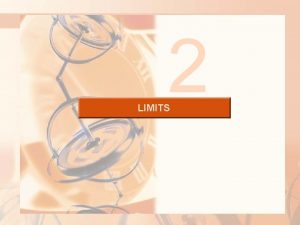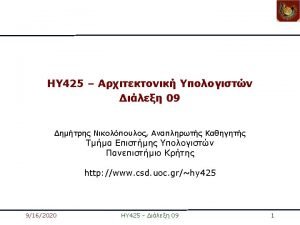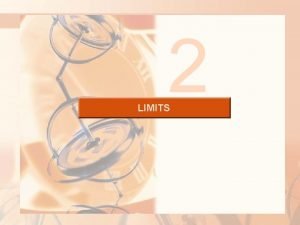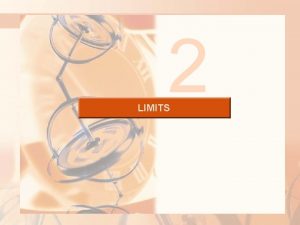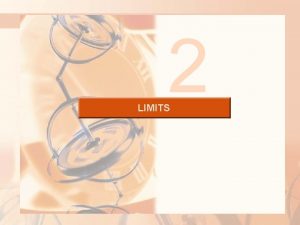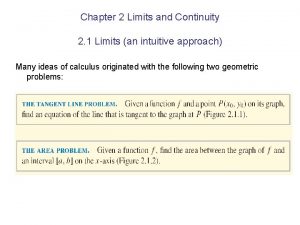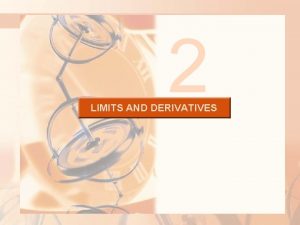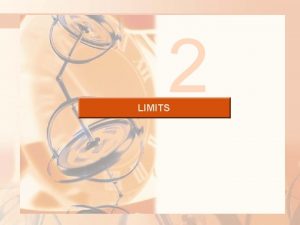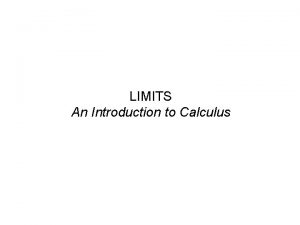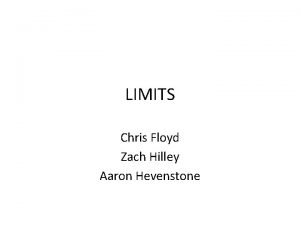Limits I Why limits II What are limits











































- Slides: 43

Limits I. Why limits? II. What are limits? III. Types of Limits IV. Where Limits Fail to Exist V. Limits Numerically and Graphically VI. Properties of Limits VII. Limits Algebraically VIII. Trigonometric Limits IX. Average and Instantaneous Rates of Change X. Sandwich Theorem XI. Formal Definition of a Limit

Why limits? Limits help us answer the big question of how fast an object is moving at an instant of time. For Newton and Leibniz, this had to do with the velocity a planet moved in its orbit around the sun.

Why limits? We might be more interested in the velocity of other things

Why limits? The fundamental concepts of calculus - the derivative and the integral are both defined in terms of limits. We will see more of these as we learn how to use limits. Derivative Integral

Why limits? So limits are like the engine under the hood of a car. We are mainly interested in driving the car and won’t spend a lot of time thinking about what is happening under the hood, but we should have a basic understanding of how the engine works.

What are limits? Limits describe the behavior of functions around specific values of x. They also describe the end behavior of functions. More specifically, limits describe where the yvalue of a function appears to be heading as x gets closer and closer to a particular value or as x approaches positive/negative infinity. Let’s look at these ideas a little closer.

What are limits? Some important notes about limits: a. Limits are real numbers, but we sometimes use to indicate the direction a function is heading.

What are limits? Some important notes about limits: b. Limits do not depend on the value of the function at a specific x value, but on where the function appears to be heading.

What are limits? c. For a limit to exist, the function must be heading for the same y-value whether the given x-value is approached from the left or from the right, i. e. one-sided limits must agree.

Types of Limits There are three basic forms of limits ( ): a. Limits at a finite value of x b. Infinite limits (vertical asymptotes) c. Limits at Infinity (horizontal asymptotes or end behavior)

Infinite Limits Infinite limits occur in the vicinity of vertical asymptotes. Functions may approach positive or negative infinity on either side of a vertical asymptote. Remember to check both sides carefully. Also, remember to simplify rational expressions before identifying vertical asymptotes.

Infinite Limits Ex. 1 Determine the limit of each function as x approaches 1 from the left and from the right.

Infinite Limits Ex. 2 Identify all vertical asymptotes of the graph of each function.

Limits at Infinity Remember: logarithmic Evaluate: polynomial exponential factorial ? ? ? ? ?

Limits at Infinity Video

Limits at Infinity

Limits at Infinity

Where Limits Fail to Exist There are three places where limits do not exist: Jump Discontinuities Vertical Asymptotes Oscillating Discontinuities

Limits Numerically 1 Use the Tbl. Set (with Independent set to ASK) and TABLE functions on your graphing calculator to estimate the limit.

Limits Numerically 2 Use the Tbl. Set (with Independent set to ASK) and TABLE functions on your graphing calculator to estimate the limit.

Limits Numerically 3 Use the Tbl. Set (with Independent set to ASK) and TABLE functions on your graphing calculator to estimate the limit.

Limits Graphically 1

Limits Graphically 2

Limits Graphically 3

Limits Graphically 4

Properties of Limits 1 Some examples: Thinking graphically may help here.

Properties of Limits 1 Ex. 1

Properties of Limits 1 Ex. 2

Properties of Limits 1 Ex. 3

Properties of Limits 2

Properties of Limits 2 Ex. 1 Use the information provided here to evaluate limits a – d here

Properties of Limits 2 Ex. 2 Use the information provided here to evaluate limits a – d here

Properties of Limits 3 For example, evaluate the limit

Properties of Limits 4 For example:

Properties of Limits 5 For example, evaluate the limit

Properties of Limits 6 For example, given: Evaluate the limit:

Limits Algebraically In addition to Direct Substitution, there are many strategies for evaluating limits algebraically. In particular, we will focus on three of them: I. Factor and Cancel II. Simplifying Fractions III. Rationalization

Factor and Cancel

Simplifying Fractions Basic Strategy: Multiply numerator and denominator by 3(3+x) and then simplify. You could also find a common denominator for both fractions in the numerator and then simplify that first.

Rationalization

Trigonometric Limits There are two special trigonometric limits:

Trigonometric Limit Ex. 1 Basic strategy:

Trigonometric Limit Ex. 2 Strategy: Multiply numerator/denominator by 4 Let and note that as ,
 Antigentest åre
Antigentest åre Pictures
Pictures Infinite limits and limits at infinity
Infinite limits and limits at infinity Histogram polygon graph
Histogram polygon graph Dont ask why why why
Dont ask why why why Success criteria for a speech
Success criteria for a speech Why-why analysis
Why-why analysis Wh tongue twisters
Wh tongue twisters Does this table represent a function why or why not
Does this table represent a function why or why not What does a table represent
What does a table represent Why or why not
Why or why not Analisa akar masalah
Analisa akar masalah Dts gate motor pc board price
Dts gate motor pc board price Limits calculator
Limits calculator 117 rest rules
117 rest rules The limits of quantum computers
The limits of quantum computers Limit and continuity solved problems
Limit and continuity solved problems Limits involving infinity asymptotes of graphs
Limits involving infinity asymptotes of graphs Evaluating limits graphically
Evaluating limits graphically Royal london medical underwriting limits
Royal london medical underwriting limits Attribute control charts
Attribute control charts Content uniformity test definition
Content uniformity test definition Natural tolerance limits in quality control
Natural tolerance limits in quality control Dose limits radiology
Dose limits radiology The limits of objective activity
The limits of objective activity Limit of trigonometric functions
Limit of trigonometric functions Limits to arbitrage
Limits to arbitrage Limits of trigonometric functions
Limits of trigonometric functions Limits with two variables
Limits with two variables Limits fits and tolerances
Limits fits and tolerances Horizontal asymptote limits
Horizontal asymptote limits Squeezing theorem
Squeezing theorem Cladding deflection limits
Cladding deflection limits Limitation of accuracy
Limitation of accuracy Neurotic needs
Neurotic needs L'hopital's rule cases
L'hopital's rule cases Radiation dose limits for workers and public pdf
Radiation dose limits for workers and public pdf Susi grant rates
Susi grant rates Analyzing limits graphically
Analyzing limits graphically What are class limits in statistics
What are class limits in statistics Deflection requirements
Deflection requirements How to calculate fraction defective
How to calculate fraction defective Construction of p chart
Construction of p chart Confined space gas limits
Confined space gas limits













